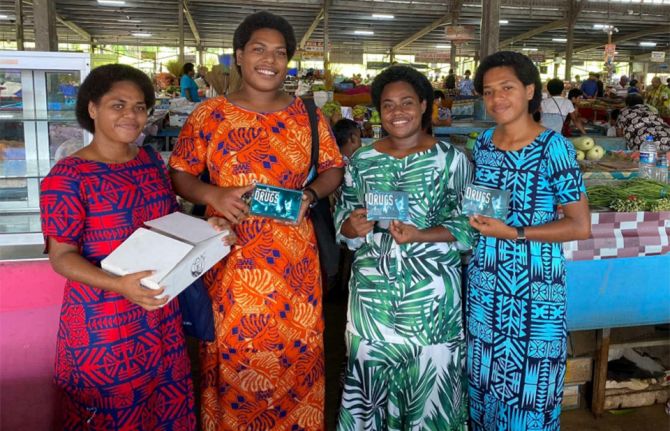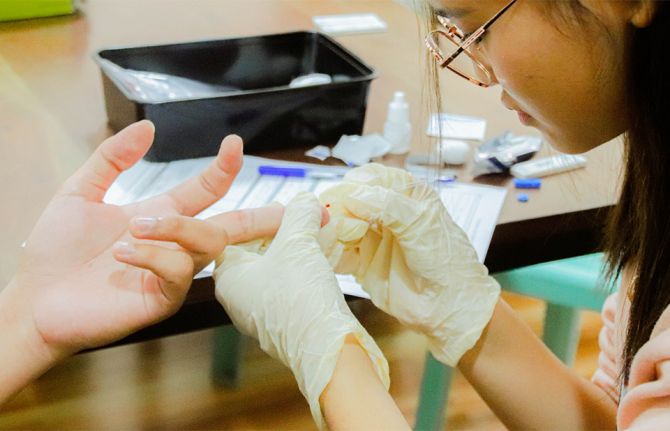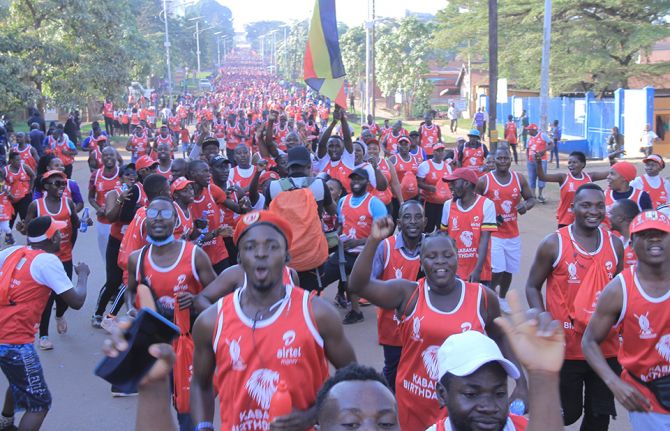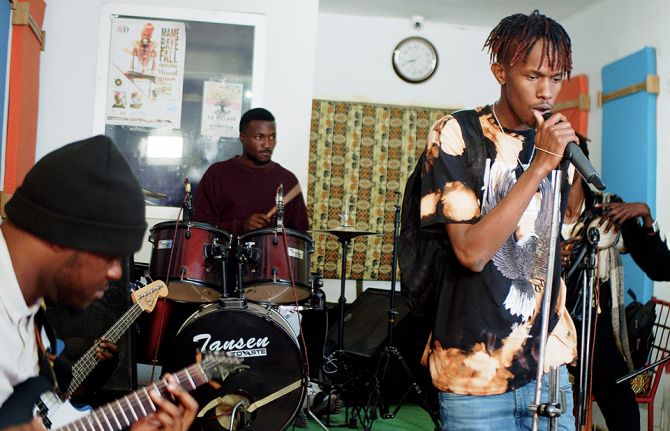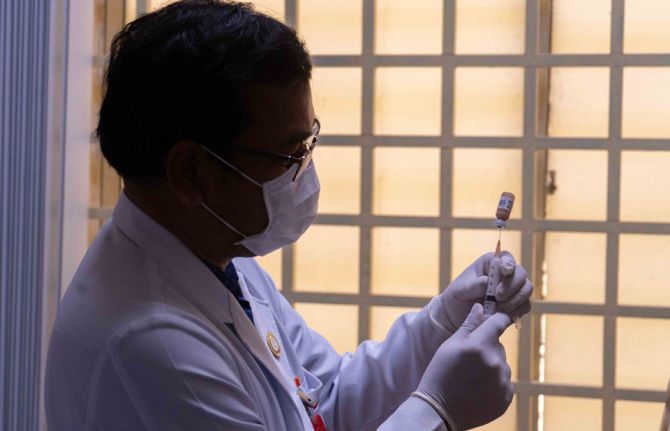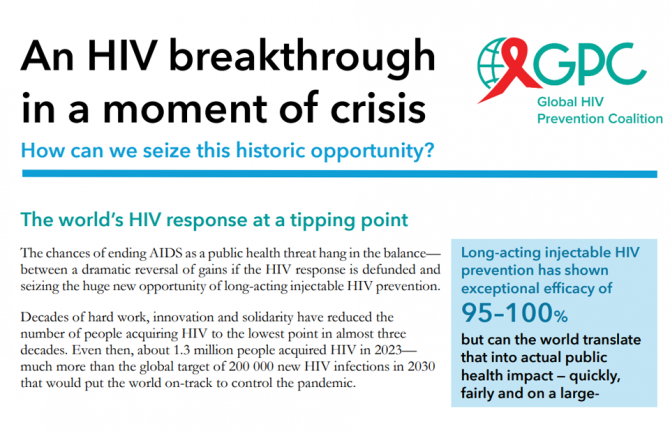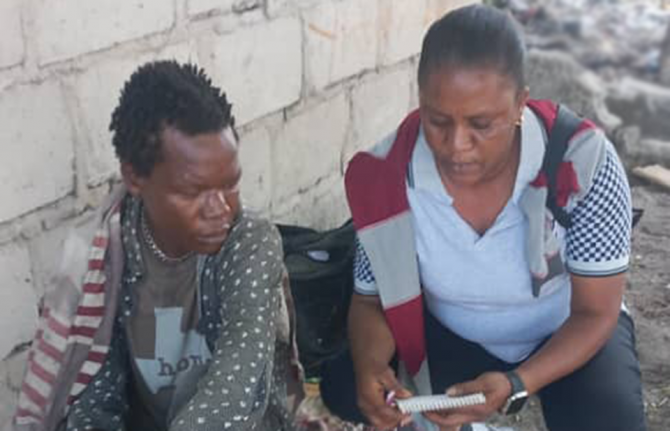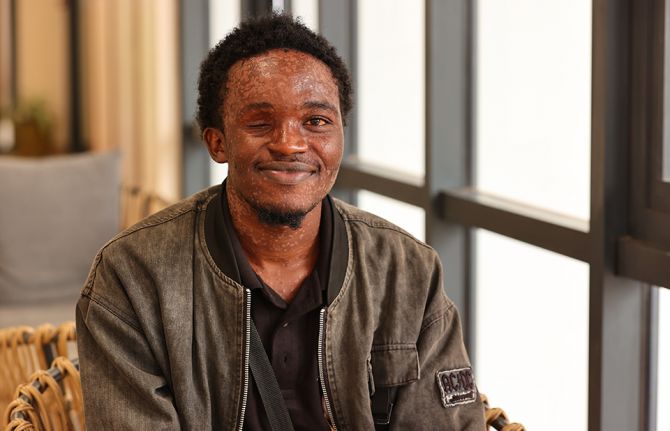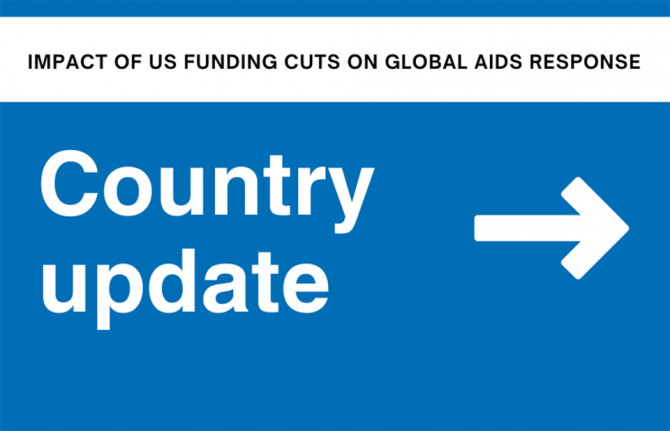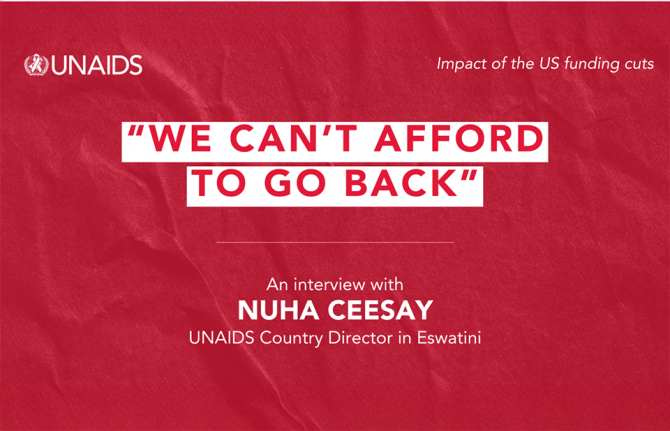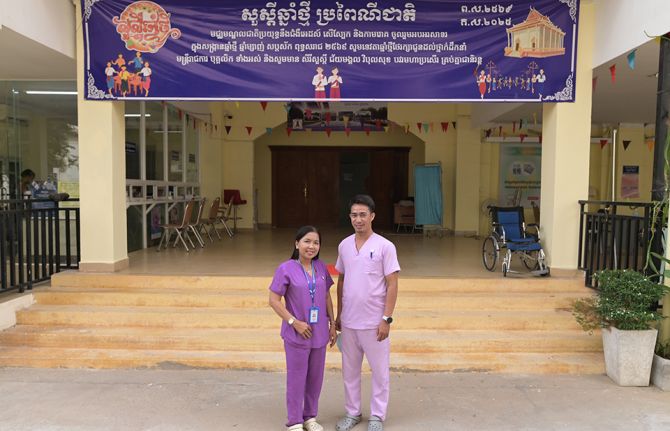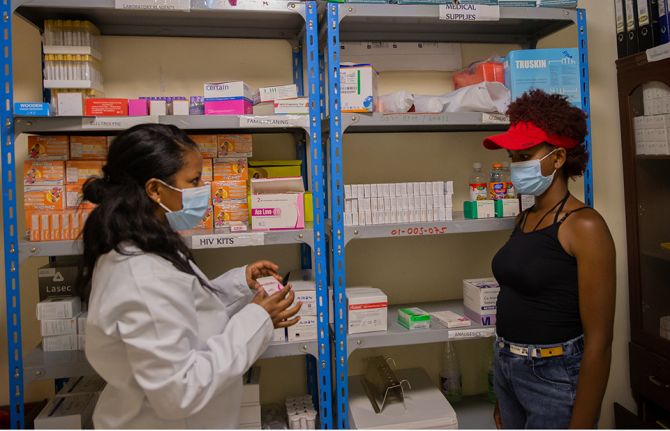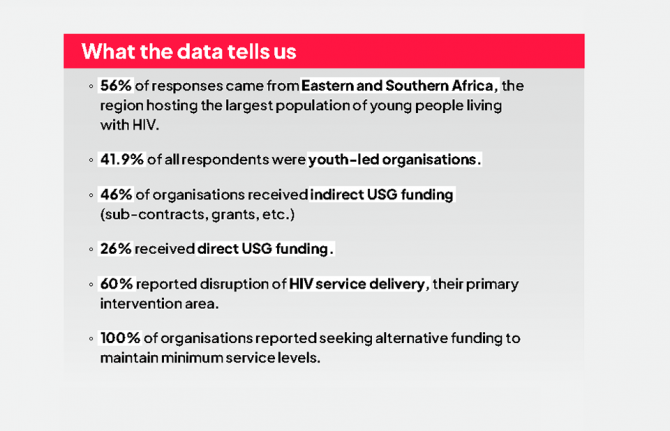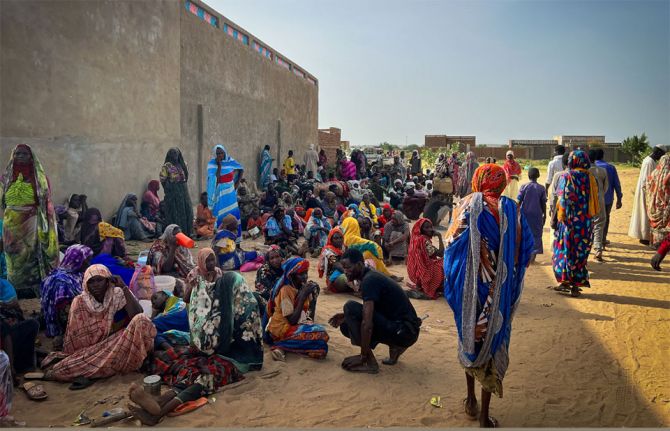
Feature Story
New initiative to train India’s people living with HIV on AIDS advocacy in the workplace
07 October 2009
07 October 2009 07 October 2009Today, October 7 2009, we mark World Day for Decent Work. The International Labour Organization, a Cosponsor of UNAIDS, works towards achieving the globally endorsed goal of Decent Work. Rights at work include freedom from discrimination, expansion of employment opportunities, social protection for all and social dialogue.

Supporting the rights of people living with HIV in the workplace: The Honourable Shri Mallikarjun Kharge, Union Minister of Labour and Employment (speaking) and Syed Mohammad Afsar, ILO’s HIV and AIDS Technical Specialist for South Asia and National Project Coordinator for India
Picture courtesy of ILO
An innovative tool in India’s response to HIV in the world of work has just been launched by the International Labour Organization (ILO) and the India Network of People living with HIV/AIDS (INP+). The two organizations have come together to release a unique training video and handbook package aimed at guiding those living with the virus in AIDS advocacy in the workplace.
Unveiled by the Honorable Shri Mallikarjun Kharge, Union Minister of Labour and Employment, the package contains testimonies from people living with HIV (PLHIV) in workplace settings as this has proven to be a very effective training initiative in the past. Practical, and offering step-by-step guidelines, it is designed to encourage HIV-positive people to be open about their status and spread the message of tolerance, anti-discrimination and respect for human and employment rights for those affected by the virus across the country.
The video and handbook have been developed with contributions from more than 100 people living with HIV and are available in both English and Hindi.
We cannot stress enough the importance of the rights of people living with HIV – to respect, dignity, access to care and treatment, and here in this project, the right to work. Building the capacity of people to advocate this is critical and we salute the achievements of ILO and INP+ in this regard.
Charles Gilks, UNAIDS Country Coordinator, India
One active participant in this process is Hari Singh, a board member of the Delhi Network of People Living with HIV, who has been working with the ILO in advocacy initiatives since 2007. He spoke at the launch of his growing confidence in talking about his HIV status. He now speaks to employers, workers and trade unions about his life experience and provides clear and specific anti-AIDS messages.
As in many other countries and communities, AIDS stigma and discrimination are still rife in Indian society, including the workplace, and a number of individuals have been hounded from their jobs because of their status. According to Naveen Kumar of the Delhi Network of Positive People, this can have devastating consequences: “If you take away our jobs, you will kill us faster than HIV.” Removing punitive laws, policies, practices and stigma and discrimination that block effective responses to AIDS is one of the nine priority areas in the UNAIDS Outcome Framework 2009-2011.
This latest intervention is part of an ongoing umbrella project spearheaded by the ILO in India, the first country in the world to implement an ILO technical cooperation project on HIV following the creation of the agency’s programme on HIV/AIDS and the world of work in 2001. From the very beginning, a person living with HIV has been represented on the ILO Project Management Team.
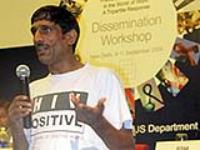
Hari Singh addresses the launch of the video and handbook package. He has been working with the ILO to make sure that the voices of PLHIV are heard in the workplace.
Picture courtesy of ILO
“The ILO in partnership with INP+ has been actively pursuing the principle of right to employment and other basic employment-related rights of PLHIV in the development and implementation of HIV workplace policies and programmes,” explains K.K. Abraham, INP+ president.
As Syed Mohammad Afsar, ILO’s HIV and AIDS Technical Specialist for South Asia and National Project Coordinator in India maintains, “Work is just as important as treatment for people living with HIV. The ILO Code of Practice on HIV/AIDS and the world of work includes non-discrimination for purposes of employment as one of its key principles. People should be allowed to work and earn a living as long as they are fit to work.”
The ILO India project has been supported by the United States Department of Labour and, more recently, by the US President's Emergency Plan for AIDS Relief (PEPFAR). It is now seen by many as something of a yardstick for other programmes executed by the ILO with ministries of labour and with employers’ and workers’ organizations to address AIDS in the world of work.
“In the ILO project, we have been building the capacity of people living with HIV and engaging them from the beginning. So far, 165 PLHIV from 20 networks in India have been trained in workplace advocacy programmes,” Mr Afsar added.
According to Charles Gilks, the UNAIDS Country Coordinator for India, the initiative is highly welcome. “We cannot stress enough the importance of the rights of people living with HIV – to respect, dignity, access to care and treatment, and here in this project the right to work. Building the capacity of people to advocate this is critical and we salute the achievements of ILO and INP+ in this regard.”
New initiative to train India’s people living wit
Cosponsors:
Partners:
India Network of People Living with HIV/AIDS (INP+)
United States Department of Labour (USDOL)
Multimedia:
Watch Prevention of HIV in the World of Work on YouTube
Feature stories:
Morocco: Coming together to strengthen the AIDS response in the workplace (10 July 2009)
International Labour Conference tackles HIV in the world of work (03 June 2009)
ILO and workplace leaders pledge action at ICASA 2008 (04 December 2008)
International labour standard would strengthen the HIV response in the workplace (21 July 2008)
ILO sees significant improvement in workplace attitudes to HIV (25 April 2008)
Health workforce crisis limits AIDS response (29 February 2008)
Publications:
AIDS is everybody's business: UNAIDS & business - working together (pdf, 863 Kb.)
Employers' handbook on HIV/AIDS: a guide for action (pdf, 609 Kb.)
UNAIDS Outcome Framework 2009-2011 (pdf, 396 Kb.)

Feature Story
Gender and sexuality: Partners gather for global expert forum in Asia
06 October 2009
06 October 2009 06 October 2009
A HIV outreach peer worker chats with a transgendered person in Pattaya, Thailand. Credit: UNAIDS/Vinai Dithajoh
Across the world sex workers, men who have sex with men, transgender people, and other sexual minority groups are disproportionally affected by HIV yet often face considerable challenges in accessing healthcare and other services.
To address the technical and political challenges of securing resources for these key populations while also supporting strong country ownership, the Global Fund to fight AIDS, TB and Malaria (Global Fund), UNAIDS and the Coalition of Asia Pacific Regional Networks on HIV/AIDS is hosting a global expert consultation in Bangkok, 5-7 October 2009.
Mr Prasada Rao, UNAIDS Director for Regional Support Team Asia and the Pacific, earlier opened the Global expert consultation on gender and sexual diversity, emphasising the importance of effective programming for key groups at higher risk of HIV drawing on examples from UNAIDS work in the Asia Pacific region.
Both UNAIDS and Global Fund, by sharpening their policies and priorities with regard to most at risk populations can influence countries to prioritise high impact prevention in their national plans.
Mr Prasada Rao, UNAIDS Director for Regional Support Team Asia and the Pacific
“Both UNAIDS and Global Fund, by sharpening their policies and priorities with regard to most at risk populations can influence countries to prioritise high impact prevention in their national plans.
UNAIDS has identified sexual transmission and removal of punitive laws as priorities in its Outcome Framework 2009-2011. The Global Fund is increasingly moving to funding National Strategic Applications (NSAs) rather than individual proposals. Both these policy shifts will immensely benefit MSM and transgender populations by resource availability for high impact programs,” said Mr Rao.
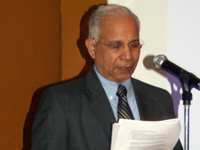
Mr Prasada Rao, UNAIDS Director for Regional Support Team Asia and the Pacific, spoke of the importance of effective programming for people at higher risk if HIV when he opened the meeting in Bangkok, 5 October 2009
Credit: UNAIDS
Mr Rao was joined by David Winters, Country Coordinating Mechanism Manager of the Global Fund; and, Vince Crisostomo Regional Coordinator of the Coalition of Asia Pacific Regional Networks on HIV/AIDS as well as representatives of sexual minority groups from around the world. The meeting brings together experts to discuss the implementation of the Global Fund’s Sexual Orientation and Gender Identities Strategy.
The Strategy, agreed by the Global Fund Board in May 2009, recognizes that key populations at higher risk of HIV face considerable challenges in being able to access or benefit from grants and face social and structural barriers in the realization of their health and rights. The consultation aims to continue collaboration between key partners on work towards resource allocation for activities related to sexual orientation and gender identities. It is also a forum to exchange experiences and practices on these activities in order to achieve a more harmonized AIDS response.
Progress in securing greater investment in HIV programming for sex workers, men who have sex with men, transgender people, and other sexual minority groups requires a strong partnership approach.
Mr Andy Seale, Senior Adviser for Sexual and Gender Diversity at the Global Fund
Andy Seale, Senior Adviser for Sexual and Gender Diversity at the Global Fund, said: “Progress in securing greater investment in HIV programming for sex workers, men who have sex with men, transgender people, and other sexual minority groups requires a strong partnership approach. We need to ensure that the same diverse partners that helped develop the Global Fund’s sexual orientation and gender identities strategy are now active in demonstrating leadership in addressing the technical and political challenges of its implementation. This meeting brings together a number of key partners in this effort.”
The consultation, is jointly organised by UNAIDS, the Global Fund and the Coalition of Asia Pacific Regional Networks on HIV/AIDS. The Global Fund finances nearly a quarter of all international spending on AIDS and two-thirds of global spending on malaria and TB. UNAIDS plays a unique link role in this effort by strengthening partnerships across sectors, including within civil society and communities.
The Coalition of Asia Pacific Regional Networks on HIV/AIDS is a broad-based alliance that brings together seven regional networks that have experience and expertise in initiating and implementing programmes dealing with affected communities and vulnerable populations. The Network builds upon partnerships to ensure effective responses at grassroots level.
Gender and sexuality: Partners gather for global
Partners:
The Global to Fight AIDS, TB and Malaria
Coalition of Asia Pacific Regional Networks on HIV/AIDS
Feature stories:
Commission on the Status of Women opens with call for action to achieve universal access and gender equality (02 March 2009)
Publications:
Joint action for results: UNAIDS outcome framework, 2009 – 2011 (pdf, 388 Kb.)
The Yogyakarta Principles (pdf, 406 Kb.)
22nd PCB: Gender-sensitivity of AIDS Responses (pdf, 211 Kb.)

Feature Story
Michel Sidibé urges India to continue AIDS effort
06 October 2009
06 October 2009 06 October 2009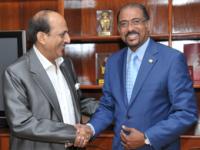
UNAIDS Executive Director Michel Sidibe with Minister of State for Health and Family Welfare Mr Dinesh Trivedi.
Photo: UNAIDS India
In his first visit to India as Executive Director of UNAIDS, Michel Sidibé has held a series of meetings with the Government in which he emphasized the role of political leadership to ensure that the country’s universal access goals to HIV prevention, care and treatment are achieved in India by 2010.
In Delhi, Mr Sidibé congratulated the Indian government for the progress made in the HIV response. He spoke in a meeting with Ms K. Sujatha Rao, Health Secretary, Ministry of Health and Family Welfare, praising the results achieved by the Ministry and the National AIDS Control Organisation (NACO) in expanding access to HIV treatment beyond the targets set by the country, as well as the implementation of targeted programmes which are having a positive impact on HIV transmission rates.
The UNAIDS Head also expressed his support for the recent decision of a Delhi court to annul Section 377 of the Indian Penal Code that criminalised homosexuality in India. The historic decision is a breakthrough for rights groups in India and strengthens the NACO’s efforts to reach out to the people at higher risk of HIV, like men who have sex with men and transgendered people.
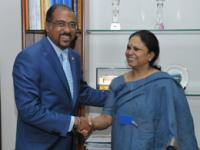
UNAIDS Executive Director Michel Sidibe with Ms. K. Sujatha Rao, Health Secretary, Ministry of Health & Family Welfare
Photo: UNAIDS India
Meeting with Mr Dinesh Trivedi, Minister of State for Health, Mr Sidibé urged him to guard against complacency towards HIV response in the face of other emerging challenges such as H1N1 and climate change-related health issues. He appealed for India to strengthen its role in the UNAIDS programme coordinating body and become a donor to UNAIDS in view of the country’s increased political and economic status in the world community.
Mr Sidibé will hold a series of meetings with other State officials this week as well as with civil society and private sector representatives.
The epidemic in India
There are an estimated 2.4 million people living with HIV in India, the highest in any country in Asia. For every 100 people living with HIV in India, 61 are men and 39 women; prevalence is also high in the 15-49 age group.
The epidemic, like in most of Asia, is concentrated among key populations at higher risk of HIV. Currently, six states are classified with having a high HIV prevalence – Maharashtra in the west, Andhra Pradesh, Karnataka and Tamil Nadu in the south, and Manipur and Nagaland in the northeast. According to recent data, new pockets of concern are now emerging in North India as well.
The independent Commission on AIDS in Asia has noted that India has significantly increased domestic spending on HIV in recent years, accounting for nearly 50% of the country’s total AIDS budget. Mr Sidibé’s visit to India will continue in the coming days and will events in Mumbai and Bangalore.
Michel Sidibé urges India to continue AIDS effort
Press centre:
UNAIDS statement on population based study in south India
India expands monitoring of AIDS epidemic
Multimedia:
Feature stories:
Landmark Delhi High Court decision recognizes inappropriate criminalization as a barrier to health, human rights and dignity (07 July 2009)
State legislators in India pledge to advance universal access to HIV services as a political goal (24 February 2009)
Publications:
AIDS in Asia: Face the facts (pdf, 9.45 Mb.)
Report of the Commission on AIDS in Asia (pdf, 1.6 Mb.)

Feature Story
Telecom: Tools connecting the world and communicating about HIV
05 October 2009
05 October 2009 05 October 2009
ITU TELECOM WORLD 2009 welcomes Youth Forum participants.
Credit: ITU / F. Rouzioux
Digital and technological revolutions have dramatically changed the way in which people communicate around the world. Many communities in developing countries don’t yet have access to computers and the internet however according to the International Telecommunications Union (ITU) an estimated 2.2 billion mobile phone users lived in developing countries by end 2008 – 64% of the global market. Estimates show that by 2012, half of all individuals in remote areas of the world, who often do not have access to clean running water, electricity or the Internet, will have mobile phones.
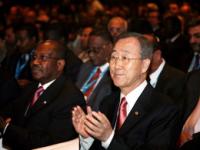
H.E. Mr Ban Ki-Moon, UN Secretary-General and Dr Hamadoun Touré Secretary General of the International Telecommunication Union (ITU) observing the vibrant Opening Ceremony of TELECOM 2009
Credit: ITU / F. Rouzioux
The ITU is gathering the global telecommunications sector together in Geneva this week for Telecom WORLD 2009. The United Nations Secretary-General Ban Ki-moon opened the conference on 5 October. Delegates will explore areas of societal change including the digital divide, climate change, and disaster relief. With its focus on development opportunities, the event brings together corporate social responsibility and displays cases of best practices.
The explosion of mobile technology presents a great opportunity to scale up the AIDS response in poor countries.
UNAIDS Executive Director Michel Sidibé is convinced of the value of this approach. “Communication tools are reaching more and more people even in the most remote villages. They connect us all into a global community,” he said.
Harnessing technology in creative ways will help us reach people in need. I want universal access to HIV prevention, treatment, care and support services to be as ubiquitous as mobile phone coverage.
UNAIDS Executive Director Michel Sidibé
“Harnessing technology in creative ways will help us reach people in need. I want universal access to HIV prevention, treatment, care and support services to be as ubiquitous as mobile phone coverage,” Mr Sidibé continued.
Mobile technologies and the AIDS response
Through mobile technology, the millions of people in developing countries who had been left behind by the digital divide are now able to access health information and healthcare services at their fingertips. Mobile phones are being used as low-cost tools for HIV testing, data collection, epidemic tracking, and training of health workers, HIV prevention and treatment support.
Some innovative examples include the HIV awareness and testing campaign via SMS (“Text to Change”, Uganda); HIV testing and treatment support with mobile phones (“Project Masiluleke”, South Africa); strengthening health systems via mobile phones (“Phones for Health”, Rwanda); and smart cards to monitor HIV patients (India and Zambia). These are a small part of the growing field of mHealth, whereby mobile communications, such as mobile phones and portable digital assistants (PDAs), are used for health services and information. mHealth programmes are gaining prominence in regions worldwide.
SMS messages can help change behaviour
Short message service (SMS) messages now offer a cost-effective, and efficient method of disseminating health messages in developing countries. According to the UN Foundation report mHealth for Development: The Opportunity of Mobile Technology for Healthcare in the Developing World, formal studies and anecdotal evidence demonstrate that SMS alerts have a greater impact in influencing behaviour than radio and television campaigns.
SMS alerts are also relatively unobtrusive, offering the user confidentiality in environments where HIV is often taboo. In developing countries, SMS alerts have proven highly effective in targeting hard-to-reach populations in rural areas, where the absence of clinics, lack of healthcare workers and limited access to health information often prevent people from making informed decisions about their health.
SMS campaigns on HIV testing and treatment support
A growing number of countries, largely in Africa, are partnering with local mobile phone carriers to launch HIV awareness and testing campaigns via SMS. These campaigns have been particularly effective in providing young people with the facts about HIV and encouraging them to get tested. Mobile phones have also been used to encourage people living with HIV to take their medication and go to their medical appointments. Taking HIV medication regularly is crucial to avoiding drug resistance.
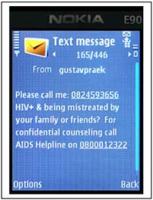
Project Masiluleke uses mobile technology to encourage South Africans to get tested for HIV. It sends one million “Please call me” text messages each day throughout South Africa, encouraging people to get tested and treated for HIV. The SMS messages are written in local languages, and are used to direct users to the National AIDS Helpline. Once patients call, the hotline representatives provide information on HIV testing services and locations. Knowing one’s HIV status is critical in a country where almost 20% of the population is living with HIV, but less than 3% know their status.
Using mobile technology for diagnosis and data collection
Health workers in remote areas with no health facilities are now able to diagnose and provide treatment support to people living with HIV through wireless access to medical information databases or medical staff. As a result, patients are able to receive treatment in their villages and homes.
Furthermore, data collection from remote areas is much faster, reliable and more efficient through mobile technology. Innovative initiatives such as “Phones for Health” are helping to close the information gap that exists for patient data in developing countries, allowing decision-makers to make smarter investments by allocating resources where they are needed most. Data collection is a crucial component of HIV programmes in developing countries as policymakers and health providers at the national, district and community level need accurate data to determine the effectiveness of existing programmes and shape new policies.
GIS mapping to strengthen HIV programmes
WHO in collaboration with its partners is strengthening HIV surveillance, prevention and treatment programmes in countries by using a global information and mapping system compiled through remote field data collection tools, wireless applications and satellite systems. This allows WHO to monitor and analyze the epidemiological trends in HIV infection worldwide as well as the effectiveness of HIV prevention and treatment programmes. For example, the data collected through the mapping system can help health experts determine which health centres have sufficient stock of antiretrovirals (ARVs).
Web-based technology to fight HIV
In addition to mobile technology, web-based technology is also revolutionizing the way health information is disseminated across the globe. A large proportion of people worldwide are now able to access information about HIV transmission, prevention, care and treatment with the click of a mouse.
When it comes to educating young people about HIV, the Joint United Nations Programme on HIV/AIDS (UNAIDS) and its Cosponsors, particularly UNICEF, UNFPA and The World Bank, are using the web in innovative ways to disseminate messages about HIV prevention.
In 1998, UNAIDS and UNICEF partnered with MTV to launch the award-winning Staying Alive campaign. Ten years later, it has become the world’s largest, youth-focused, HIV prevention campaign. UNICEF’s Voices of Youth website offers young people a safe and supportive space where they can explore, discuss and partner on health, development and human rights issues, including ways to stop the spread of HIV.
Tapping into viral communication trends
Social media networks such as Facebook, MySpace, and Twitter are gaining popularity worldwide. These examples of viral communication encourage greater interactivity whereby information is disseminated more broadly and quickly. This trend is accelerating the pace at which information is communicated, and its potential to reach new audiences with precise and tailored messages is impressive.
Like many organizations, UNAIDS is increasing its use of social media networks to get its messages out to new and existing audiences. UNAIDS has a presence on both Facebook and Twitter and engages with the sites’ users by posting regular updates and encouraging user comments and feedback. Content-sharing sites like Flickr and YouTube also enable UNAIDS to share its audiovisual content to people worldwide.
The aim of using social media networks is simple: to disseminate messages about HIV and encourage young people to take action to stop the spread of HIV.
Looking ahead
As new technologies continue to evolve, so will the way in which countries respond to HIV. By staying on top of emerging technology trends, countries will be able to use innovative tools to provide people, even in the most remote villages, with access to HIV prevention and treatment services.
Telecom: Tools connecting the world and communica
Cosponsors:
Press center:
Remarks to ITU Telecom World 2009 by United Nations Secretary General, Ban Ki-moon
Feature stories:
Public-private partnerships strengthen health systems and AIDS response (27 July 2009)
External links:
Visit UN Secretary General website
TELECOM WORLD 2009
Voices of Youth
MTV Staying Alive campaign
Publications:
UNAIDS Guidelines for working in partnership with the Private Sector (pdf, 38.9 Kb.)
UNAIDS & Business: Working Together (pdf, 1.60 Mb.)
Partnerships with the Private Sector: A Collection of Case Studies from UNAIDS (pdf, 1.36 Mb.)

Feature Story
OPINION: HIV vaccine—a public good to right a global wrong
02 October 2009
02 October 2009 02 October 2009By Michel Sidibé, Executive Director, Joint United Nations Programme on HIV/AIDS (UNAIDS) Geneva, Switzerland
The promise of a vaccine against HIV has got one step closer. Results from the largest vaccine trial ever conducted show a modest but encouraging 31% efficacy in preventing new HIV infections in Thailand. This has vindicated thousands of scientists and volunteers who have been hoping that a safe and highly effective HIV vaccine is possible.
An acceptable vaccine is not yet ready, but let us prepare today for tomorrow. Let us learn from the lessons of the AIDS response thus far.
Michel Sidibé, Executive Director of UNAIDS
This news comes at a time when the movement to achieve universal access to HIV prevention and treatment is gaining momentum. Today more than 4 million people living with HIV are receiving antiretroviral treatment and fewer babies are being born with HIV. With less than half the people who need treatment having access and with each day more people becoming infected with HIV than are started on treatment, we are mortgaging our future. But we are also exposing a fundamental social injustice—between the privileged and the forsaken—a divide we can bridge.
An acceptable vaccine is not yet ready, but let us prepare today for tomorrow. Let us learn from the lessons of the AIDS response thus far.
The first challenge is access and affordability. Antiretroviral treatment has been around since 1996, but real access to treatment began only when public pressure was put on world leaders and the prices of medicines came down. Today, AIDS activists are repeating these efforts to reduce prices, this time for second line antiretroviral medicines. It is unacceptable that 98% of pregnant women in developed countries are able to access HIV prophylaxis to stop transmission to their babies when little more than 33% in developing countries can do so.
The news coincides with this week’s United Nations General Assembly. During which the Secretary-General reminded us of “our commitment to equity” and where I appealed to many Heads of State who are committed to promoting equity to place equity in the AIDS response high on their list. We must not allow cost to deter people from access to a vaccine.
The second challenge is creating the conditions for massive uptake of an effective vaccine. Time and again, women and girls are unable to make independent decisions about their health and education. Many men and women do not come forward to take an HIV test for fear of stigma and discrimination. People without a voice—sex workers and their clients, injecting drug users and men who have sex with men—are often excluded from health and social welfare programmes. We look to civil society to continue to break down the barriers to vaccine uptake.
The third challenge is in creating health systems capable of delivering the vaccine. Currently clinics are geared towards immunizing infants and young children. The largest benefits of an HIV vaccine will likely accrue from vaccinating the present cohort of young people and those at higher risk of HIV exposure. A failure to reach adolescents will represent another failure to break the back of the epidemic.
There is no time for complacency in our efforts to stop new HIV infections. The world needs a strong HIV prevention campaign that is evidence-informed and grounded in human rights. It is high time to end discrimination, bad laws, and harmful social norms that fuel HIV transmission.
As scientists and world leaders absorb the implications of the Thai study results in the coming weeks they must be mindful of these challenges. A “ready to use” vaccine is years—perhaps decades away, but when it does become available, it ought to be financed as a public good that is accessible for all. How else can we reasonably expect to put an end to this epidemic?
OPINION: HIV vaccine—a public good to right a glo
Press centre:
Largest ever HIV vaccine trial results are very encouraging (24 September 2009)
Publications:
Making HIV trials work for women and adolescent girls (July 2008) (pdf, 140 Kb.)
Ethical considerations in biomedical HIV prevention trials (pdf, 750 Kb.)
Good participatory practice guidelines for biomedical HIV prevention trials (pdf, 3.04 Mb.)

Feature Story
Governments and civil society expand access to HIV testing and counselling
30 September 2009
30 September 2009 30 September 2009This story has also been published at www.who.int/hiv

Photo credit: WHO
A brightly coloured van known as the ‘Tutu Tester’ has become a familiar sight in Cape Town, South Africa, as part of an accelerating drive to persuade people to know their HIV status. More than 10 000 people have been tested and counselled since May 2008 when the mobile clinic from the Desmond Tutu HIV Foundation took to the road.
It is one of many initiatives in sub-Saharan Africa designed to dispel the stigma and fear long associated with AIDS through imaginative campaigns ranging from sex worker advice at truck stops to peer counselling in mining areas to national testing weeks spearheaded by celebrities. The campaigns are part of wider national and international efforts to expand the number of people receiving testing and counselling—which is often referred to as ‘the gateway to HIV prevention, treatment and care’ because it is a precondition for timely access to all three, including antiretroviral therapy which cuts mortality rates.
Ninety percent of low- and middle-income countries last year reported that they have national HIV testing and counselling polices, up from 70% in 2007, according to the 2009 Towards universal access progress report, published by WHO, UNICEF and UNAIDS. Countries hardest hit by the pandemic—Botswana, Kenya, Lesotho, Malawi, Namibia, Rwanda, South Africa, Swaziland, Tanzania and Uganda—are testing and counselling pregnant mothers as the basis for prevention of mother-to-child transmission (PMTCT) to cut the number of infants born with HIV, and to help HIV-negative pregnant women stay negative.
There is encouraging evidence that more countries are adhering to WHO-UNAIDS guidance on provider-initiated testing and counselling in health facilities. This recommends HIV testing and counselling as part of the standard care to all persons with symptoms or medical conditions that could indicate HIV infection, to infants born to HIV-positive women, and in generalized epidemics to all persons attending health facilities. The guidelines are key to facilitating early diagnosis in countries which are struggling with a dual HIV-TB epidemic.
The number of health centres providing HIV testing and counselling is on the increase. In 15 reporting nations in East, South and South-East Asia, the number of such facilities rose from 13 000 to 15 000 between 2007 and 2008; in reporting Latin American and Caribbean countries it doubled, while sub-Saharan Africa boasted a 50% increase.
Some countries have made more progress than others. Ethiopia increased its number of facilities from 1005 to 1469 and reported that 4.5 million people received testing and counselling in 2008, up from 1.9 million in 2007. At the other end of the scale, less than 10% of health centres in Nigeria and the Democratic Republic of Congo had testing and counselling facilities.
Cameroon adopted provider-initiated testing and counselling in 2007. This was part of the government commitment to increase the number of people on treatment, up from 600 in 2001 to 60 000 in November 2008, according to WHO’s National Programme Officer for HIV/AIDS in Cameroon, Etienne Kembou. Although much remains to be done to train health professionals to implement the government model at local level, Kembou says about 85% of pregnant women at health facilities agree to be tested, as do growing numbers of men. “AIDS is not stigmatised like it was in the 1990s and many people who are HIV-positive are open about it,” Kembou says, adding that the annual national testing week and peer education projects aimed at 15–25 year-olds have helped enormously.
Uganda and Kenya have expanded coverage through home-based testing and counselling, whereby trained counsellors go from door to door. The advantage is that couples can be counselled together in a familiar environment without the stigma of going into a government facility. As a result, there are fewer disclosure problems which may arise with the male or female partner testing separately. It means that undiagnosed children with the virus can access HIV services and that high-risk areas such as the Kibera slum near Nairobi can be targeted.
In nations like Botswana and Swaziland, the government drive to scale up male circumcision for HIV prevention has led to an upsurge in testing and counselling among males, an often underserved group, as a precondition for the surgical intervention. WHO’s country representative in Botswana, Eugene Nyarko, says intensified prevention campaigns targeting youth are bearing fruit. “Across the board there is an increase in testing because young people know they can benefit from interventions if they know their status.”
In South Africa, which has the highest number of people in the world living with HIV, a national population-based survey in 2008 by the Human Sciences Research Council showed that 50% of respondents over 15 years of age said they had received an HIV test, compared to 20% in 2002. Between 2005 and 2008, the percentage of women and men who reported having an HIV test in the past 12 months more than doubled.
Civil society groups in South Africa, like the Treatment Action Campaign, have mounted high profile ‘Get Tested’ campaigns. There are many local initiatives backed by foreign donor funding and the government, and the message is getting through.
Sweetness Mzoli, runs an organisation called Kwakhanya (‘Light’) which helps care for 300 beneficiaries in Khayelitsha, a poor suburb of Cape Town with high HIV prevalence. She tours minibus taxi ranks trying to persuade men to be tested and counselled and notes there is far less resistance than even a year ago. “It’s coming right. There’s a lot of men out there who want to talk about their status and who want to know their status,” she comments.
The ‘Tutu Tester’ is also a regular visitor to Khayelitsha’s taxi ranks, as well as to shopping malls and other crowded areas. The testing and counselling process is efficient, thorough and friendly. Clients can avoid lengthy queues at public health facilities, while knowing they will receive high quality, confidential service.
“When you make it quick and efficient, people are willing to undergo testing,” says project coordinator Nienke van Schaik. The mobile clinic now offers a package, including testing for hypertension and diabetes “to make it less scary,” she says. “We literally just pitch up. People see us and run off and fetch their partners and family members. People are willing to test.”
Governments and civil society expand access to HI
Cosponsors:
World Health Organization (WHO)
United Nations Children’s Fund (UNICEF)
Publications:
Towards Universal Access: Scaling Up Priority HIV/AIDS Interventions in the Health Sector (pdf, 3 Mb.)
UNAIDS Outcome Framework 2009-2011 (pdf, 388 Kb.)
Related

Feature Story
More infants protected from HIV as access to antiretroviral drugs to prevent mother-to-child transmission increases
30 September 2009
30 September 2009 30 September 2009This story has also been published at www.who.int/hiv

Credit: WHO/James Oatway 2009
Despair is giving way to cautious optimism even in the most HIV-affected African nations as antiretroviral drugs become more widely available to stop HIV-positive women from infecting their unborn child or infant, thus edging closer to United Nations targets for an HIV-free generation of children.
The prevention of mother-to-child transmission (PMTCT) is one of the most powerful tools in HIV prevention and has huge potential to improve both maternal and child health. Yet despite recent progress much work remains.
In 2008, 45% of pregnant women in low- and middle-income countries received antiretrovirals to prevent HIV transmission to their child, up from 35% in 2007 and 10% in 2004, according to the 2009 Towards universal access progress report, published by WHO, UNICEF and UNAIDS. In Eastern and Southern African nations, which have the highest rates of infection, coverage jumped to 58% in 2008 from 46% in 2007, thanks to increased national commitment and focused international support.
One important reason is that HIV testing and counselling among pregnant women is increasing with the expansion of provider-initiated approaches in health-care settings. In 2008, 21% of pregnant women giving birth in low- and middle-income countries received an HIV test, up from 15% in 2007. In sub-Saharan Africa, the corresponding percentage rose from 17% to 28%, with particularly high rates of increase in countries in Eastern and Southern Africa. This was partly due to an increase in antenatal facilities providing PMTCT services and attracting high first-visit turnouts by pregnant women.
Globally, AIDS is the leading cause of mortality among women of reproductive age. In 2008, an estimated 1.4 million pregnant women living with HIV gave birth, 91% of them in sub-Saharan Africa, according to the report. One third of children living with the virus die before the age of one year and almost half by the second year.
In 2008, 70 low- and middle-income countries had established a national scale-up plan with population-based targets to prevent mother-to-child transmission of HIV, up from 34 countries in 2005. 54 countries had plans to scale up paediatric HIV services in 2008, compared to 19 countries in 2005. An estimated 32% of the infants born to HIV-infected mothers in 2008 were reached with antiretrovirals, more than five times as many as in 2004.
UN recommendations on PMTCT are based on a four-pronged approach: primary prevention of HIV infection among women of childbearing age; preventing unintended pregnancies among women living with HIV; preventing HIV transmission from women living with HIV to their infants, and providing appropriate treatment, care and support to mothers living with HIV and their children and families.
The UN General Assembly has set a target for 80% of pregnant women and their children to have access to essential prevention, treatment and care by 2010 to reduce the proportion of infants with HIV by 50%. This would entail at least 500 000 additional pregnant women accessing PMTCT services in order to meet this target. Given that PMTCT represents the interface between HIV and maternal and child health services, this would have a positive impact on the health of women and children in general. Achieving the target remains a formidable challenge, but more and more countries are making strides in the right direction.
Botswana, long regarded as sub-Saharan Africa’s flagship in prevention, treatment and care, has easily surpassed the target, with an estimated 95% of HIV-positive pregnant women and their newborns receiving testing, counselling and antiretrovirals. PMTCT has long been one of the pillars of national prevention programmes, according to WHO country representative Eugene Nyarko. “Government commitment and responsibility has been key,” he says.
Huge progress has been made in Swaziland, which has the world’s highest HIV prevalence. More than 90% of pregnant women in public health facilities now receive counselling and testing, and most of those testing positive are given antiretrovirals, according to Derek von Wissel, director of Swaziland’s National Emergency Response Committee on HIV/AIDS. “The availability of treatment is a huge positive element. People are not as fearful of testing since they know that HIV is no longer a death sentence and that there are remedies.” Swaziland has cut its mother-to-child HIV transmission rate from a peak of more than 30% to around 20%, and the goal is to reduce it to 5% by 2014, says von Wissel. “In Botswana, the paediatric programme is slowing down because fewer and fewer infants are being infected with HIV. We will hopefully go in that direction as well,’’ he says.
Equally significantly, more countries are following WHO recommendations to use a combination of two or three antiretroviral drugs to prevent vertical transmission from mother to child. In 2007, 49% of women receiving antiretrovirals were given a single-dose regimen of nevirapine. By 2008, this had fallen to about 31%, with more women receiving the more efficacious combination of several antiretrovirals.
A survey of babies tested for HIV during routine immunization in South Africa’s KwaZulu-Natal province showed the six-week vertical HIV transmission rate was 7% in 2008/2009 compared to 20.8% in 2004/2005. The dramatic reduction was largely due to an increase in testing, counselling and treatment and the switch to a combination of more than one antiretroviral drug.
“These data demonstrate that effective antiretroviral interventions can be delivered at scale and transmission rates can be dramatically reduced,” according to the Towards universal access progress report. “From where we were five years ago, there has been a tremendous increase in coverage,” comments Hoosen Coovadia, one of the South Africa’s top professors of paediatrics and PMTCT scientists. But he says capacity constraints at local level remain a challenge, and that health authorities should do more to use PMTCT as a catalyst to widen reproductive health services and involve male partners.
Progress in general in Western and Central Africa was held back by low coverage levels in Nigeria and the Democratic Republic of Congo which bear the heaviest HIV burden in the region. Nigeria alone accounts for 30% of the global gap in the UN’s target of reaching 80% of women by 2010.
In North Africa and the Middle East, less than 1% of pregnant women living with HIV received an antiretroviral regimen to stop HIV transmission to their child. In East, South and South-East Asia the figure was 25%. Coverage in Latin America increased from 47% in 2007 to 54% in 2008, and in the Caribbean from 29% to 52%. In Europe and Central Asia, coverage jumped from 74% in 2007 to 94% in 2008.
Even in countries with strong PMTCT programmes, there is no room for complacency. Thailand, for instance, has cut mother-to-child transmission rates to less than 5%, according to Siripon Kanshana, Deputy Permanent Secretary in the Ministry of Public Health. But she says there is a need for further capacity building and more training of medical personnel—nurses in particular—in testing and counselling and in monitoring side effects of antiretrovirals and potential drug resistance. “The Ministry of Health has the commitment. But the government still needs advocacy from UN agencies to help strengthen our health care systems to cope.”
More infants protected from HIV as access to anti
Cosponsors:
World Health Organization (WHO)
United Nations Children’s Fund (UNICEF)
Press centre:
More than four million HIV-positive people now receiving life-saving treatment (30 September 2008) (pdf, 40 kb.)
Feature stories:
Evidence shows new drug combination dramatically reduces mother-to child transmission of HIV during breastfeeding (22 July 2009)
Lesotho: HIV free babies bring hope (16 July 2009)
Early diagnosis and treatment save babies from AIDS-related death (27 May 2009)
Publications:
Towards Universal Access: Scaling Up Priority HIV/AIDS Interventions in the Health Sector (pdf, 3 Mb.)
UNAIDS Outcome Framework 2009-2011 (pdf, 388 Kb.)

Feature Story
More than four million HIV-positive people now receiving life-saving treatment
30 September 2009
30 September 2009 30 September 2009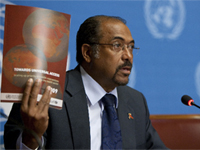
UNAIDS Executive Director presents the new WHO/UNAIDS/UNICEF report at the UN in Geneva, 30 September 2009. Credit: WHO/Christopher Black
Geneva / Paris -- More than 4 million people in low- and middle-income countries were receiving antiretroviral therapy (ART) at the close of 2008, representing a 36% increase in one year and a ten-fold increase over five years, according to a new report released today by the World Health Organization (WHO), the United Nations Children's Fund (UNICEF) and the Joint United Nations Programme on HIV/AIDS (UNAIDS).
Towards Universal Access: Scaling Up Priority HIV/AIDS Interventions in the Health Sector highlights other gains, including expanded HIV testing and counselling and improved access to services to prevent HIV transmission from mother to child.
"This report shows tremendous progress in the global HIV/AIDS response," said WHO Director-General Margaret Chan. "But we need to do more. At least 5 million people living with HIV still do not have access to life-prolonging treatment and care. Prevention services fail to reach many in need. Governments and international partners must accelerate their efforts to achieve universal access to treatment."
Treatment and Care
Access to antiretroviral therapy continues to expand at a rapid rate. Of the estimated 9.5 million people in need of treatment in 2008 in low- and middle-income countries, 42% had access, up from 33% in 2007. The greatest progress was seen in sub-Saharan Africa, where two-thirds of all HIV infections occur.
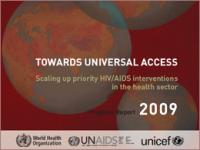
Prices of the most commonly used antiretroviral drugs have declined significantly in recent years, contributing to wider availability of treatment. The cost of most first-line regimens decreased by 10-40% between 2006 and 2008. However, second-line regimens continue to be expensive.
Despite recent progress, access to treatment services is falling far short of need and the global economic crisis has raised concerns about their sustainability. Many patients are being diagnosed at a late stage of disease progression resulting in delayed initiation of ART and high rates of mortality in the first year of treatment.
Testing and Counselling
Recent data indicate increasing availability of HIV testing and counselling services. In 66 reporting countries, the number of health facilities providing such services increased by about 35% between 2007 and 2008.
Testing and counselling services are also being used by an increasing number of people. In 39 countries, the total reported number of HIV tests performed more than doubled between 2007 and 2008.
Ninety-three percent of all countries that reported data across all regions provided free HIV testing through public sector health facilities in 2008.
Nevertheless, the majority of those living with HIV remain unaware of their HIV status. Low awareness of personal risk of HIV infection and fear of stigma and discrimination account, in part, for low uptake of testing services.
Women and Children
In 2008, access to HIV services for women and children improved. Approximately 45% of HIV-positive pregnant women received antiretroviral drugs to prevent HIV transmission to their children, up from 35% in 2007. Some 21% of pregnant women in low- and middle-income countries received an HIV test, up from 15% in 2007.
More children are benefiting from paediatric antiretroviral therapy programmes: the number of children under 15 years of age who received ART rose from approximately 198 000 in 2007 to 275 700 in 2008, reaching 38% of those in need.
Globally, AIDS remains the leading cause of mortality among women of reproductive age.
"Although there is increasing emphasis on women and children in the global HIV/AIDS response, the disease continues to have a devastating impact on their health, livelihood and survival," said Ann M. Veneman, UNICEF Executive Director.
Most-At-Risk Populations
In 2008, more data became available on access to HIV services for populations at high risk of HIV infection, including sex workers, men who have sex with men and injecting drug users.
While HIV interventions are expanding in some settings, population groups at high risk of HIV infection continue to face technical, legal and sociocultural barriers in accessing health care services.
"All indications point to the number of people needing treatment rising dramatically over the next few years," said Michel Sidibé, Executive Director of UNAIDS. "Ensuring equitable access will be one of our primary concerns and UNAIDS will continue to act as a voice for the voiceless, ensuring that marginalized groups and people most vulnerable to HIV infection have access to the services that are so vital to their wellbeing and to that of their families and communities."
More than four million HIV-positive people now re
Cosponsors
Press centre:
Download printable version (pdf, 40 Kb.)
Feature stories:
Governments and civil society expand access to HIV testing and counselling (30 September 2009)
More infants protected from HIV as access to antiretroviral drugs to prevent mother-to-child transmission increases (30 September 2009)
Contact:
In Geneva:
WHO
Saira Stewart
T: +41 22 791 2511
M: +41 79 467 2013
E: stewarts@who.int
UNAIDS
Sophie Barton-Knott
T: +41 22 791 1697
M: +41 79 514 6896
E: bartonknotts@unaids.org
In New York:
UNICEF
Kathryn Donovan
T: + 1 212 326 7452
E: kdonovan@unicef.org
In London:
Cathy Bartley
T: +44 20 8694 9138
M: +44 7958 561 671
E: cathy.bartley@bartley-robbs.co.uk
Claire Hoffman
T: +44 208 892 5215
M: +44 7977 440 353
E: claire.hoffman@bartley-robbs.co.uk
In Paris:
Michel Aublanc
T:+33 1 69 286 286
M: +33 6 08 719 795
E: michel.aublanc@orange.fr
Related

Feature Story
Y-PEER in Lebanon: Youth leadership in action
29 September 2009
29 September 2009 29 September 2009
With arts and culture being pillars of the Jeux de la Francophonie, the Y-PEER network performed a dance and song written by its members about AIDS. Beirut, 28 September 2009. Credit: UNAIDS/Nabil
The UNFPA-supported Y-PEER initiative is a groundbreaking youth programme that raises HIV prevention awareness through street art, music and dance. UNAIDS Executive Director Michel Sidibé had the opportunity this week to attend a dance performance by the Youth Peer Education Network during the Jeux de la Francophonie.
With arts and culture being one of the two pillars of the Jeux de la Francophonie, the Y-PEER network performed a dance and song written specifically by its members for these games. The lyrics include HIV prevention messages in Arabic, French and English, with the dancers forming a large red ribbon of red fabric at the end of the routine.
UNAIDS and our Cosponsors are committed to including young people’s leadership as an integral part of national responses including empowering young people to prevent sexual and other transmission of HIV infection among their peers.
Culture and creative expression are powerful tools for mobilizing people of all ages and I applaud the Y-PEER.
Michel Sidibé, UNAIDS Executive Director
“UNAIDS and our Cosponsors are committed to including young people’s leadership as an integral part of national responses including empowering young people to prevent sexual and other transmission of HIV infection among their peers,” said Mr Sidibé.
“This evening’s performance was inspiring, putting these goals into action with young people creatively participating in the AIDS response in their own terms,” said Mr Sidibé after the show. “Culture and creative expression are powerful tools for mobilizing people of all ages and I applaud the Y-PEER.”

UNAIDS Executive Director Michel Sidibé writes a message at the UNAIDS booth at Y-PEER event, Beirut, 28 September 2009. Credit: UNAIDS/Nabil
Y-PEER is a groundbreaking and comprehensive youth-to-youth initiative pioneered by UNFPA. The international network includes over 7000 young peer educators in Europe, Central Asia, Latin America, North Africa and the Middle East. The network has adopted an approach of “edutainment”—combining education and entertainment— to communicating HIV facts. Young people work together to raise awareness on sexual and reproductive health including the facts about sexually transmitted infection and HIV prevention.
The Lebanese Y-PEER network was launched in 2008 with the support of UNFPA and through 35 peer educators, the network has reached 1000 young people all over country in just three months.
With 7,400 new HIV infections daily worldwide and young people aged 15-24 accounting for 45% of these.
The Jeux de la Francophonie brings together sport and culture to foster dialogue and understanding among French speaking nations. It will run in Beirut until 6 October, bringing together 70 countries from all over the world.
Y-PEER in Lebanon: Youth leadership in action
Cosponsors:
Partners:
Feature stories:
Jeux de la Francophonie and UNAIDS: Partnering for young people (28 September 2009)
Publications:
Joint action for results: UNAIDS outcome framework, 2009 – 2011 (pdf, 388 Kb.)
Sexual and reproductive health and HIV - Linkages: Evidence review and recommendations (pdf, 786 kb.)
Preventing HIV/AIDS in young People: A systematic review of the evidence from developing countries UNAIDS Inter-agency Task Team on Young People (Report | 8 pages summary | 4 pages summary)
Related
 “Who will protect our young people?”
“Who will protect our young people?”

02 June 2025

Feature Story
UNAIDS Executive Director visits Lebanon
29 September 2009
29 September 2009 29 September 2009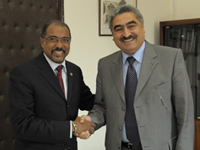
The Director General in the Ministry of Public Health, Lebanon, Dr Walid Ammar (right) met UNAIDS Executive Director Michel Sidibé. Beirut, 28 September 2009. Credit: UNAIDS/Nabil
UNAIDS Executive Director Michel Sidibé concluded an official visit to Lebanon on 29 September. Mr Sidibé recognized and supported the country’s achievements in the HIV response and efforts to target key populations at risk of HIV. He also welcomed the Government of Lebanon’s strong commitment to introduce oral substitution therapy into the country’s public health system.
Mr Sidibé met with the Director General in the Ministry of Public Health, Lebanon, Dr Walid Ammar, and commended the government’s initiative to scale up its harm reduction programme. He stressed the need to expand prevention and treatment efforts among key populations affected with HIV in order to achieve universal access goals.
Mr Sidibé also met with the Executive Secretary of the Economic and Social Commission for Western Asia, Mr Bader Al-Dafa, to discuss approaches to prevent escalation of the HIV epidemic in the countries of the Middle East and North Africa, focusing on gender, socio-economic, marginalization and other factors which increase vulnerability.
I encourage more openness in communicating about AIDS issues.
Let us all work together without judgment or discrimination for people living with or at risk of HIV
Michel Sidibé, UNAIDS Executive Director
Mr Sidibé emphasized the priority of keeping HIV prevalence low in the region, “for low prevalence to continue, I encourage more openness in communicating about AIDS issues. Let us all work together without judgment or discrimination for people living with or at risk of HIV,” said Mr Sidibé.

Mr Sidibé met with civil society groups while in Lebanon. Credit: UNAIDS/Nabil
Recognizing the pivotal role of civil society in the HIV effort, he also met with representatives from non-governmental organizations (NGOs) in the country. These included Helem Association, the first organization working with men who have sex with men (MSM) in the region as well as Soins Infirmiers et Developpement Communautaire (SIDC) which has implemented outreach and HIV prevention for MSM. He also met with Vivre Positif, which works towards ending discrimination and stigmatization towards people living with HIV.
Lebanon’s national AIDS programme has recently introduced 19 voluntary counselling and treatment centres that target key populations and are managed through NGOs. The country also recently launched a centre for antiretroviral distribution along with the provision of psycho-social support for people living with HIV.
According to UNAIDS 2007 estimates, Lebanon is a low HIV prevalence country with a total of 2900 people living with HIV. High mobility and migration levels are important drivers of the epidemic, with 45% of notified HIV cases up to 2004 being linked to travel abroad. Lebanon is among the few countries in the region that has accounted for specific strategies to target each of the key population groups.
Mr Sidibé's visit to Lebanon also included his participation in the Jeux de la Francophonie, of which UNAIDS is an official partner this year.
UNAIDS Executive Director visits Lebanon
Feature stories:
Jeux de la Francophonie and UNAIDS: Partnering for young people (28 September 2009)
New report shows Asian migrant women in the Arab states have heightened vulnerability to HIV (10 March 2009)
External links:
Publications:
Lebanon : epidemiological fact sheets on HIV/AIDS and sexually transmitted infections (pdf, 112 Kb.)
UNGASS Country Reports 2008, Lebanon (pdf, 32 Kb.)
UNAIDS Outcome Framework 2009-2011 (pdf, 388 Kb.)

